This supplemental website includes all of the media clips discussed in Reading Sounds (University of Chicago Press, 2015). Purchase your copy of Reading Sounds today in paperback or e-book.
Figure 5.1. Premature captions and ending punctuation help readers predict the future
In this clip from Taken, the final bad guy in the movie (Nabil Massad) holds a long knife to the throat of a young woman (Maggie Grace) who was kidnapped. The em dash helps us identify the exact moment when the bad guy will be shot because his utterance is interrupted mid-word — i.e. before he can finish saying “negotiate.”
Source: Taken, 2008. DVD. Featured caption: “We can nego–“
Figure 5.2. A compilation of six frames from A Serious Man with accompanying captions that display ending commas or no ending punctuation
Each caption alerts readers that the current speaker will continue to hold the floor into the next caption. Frames 1 and 2 (reading across) have no ending punctuation. Frames 3, 4, 5, and 6 make use of ending commas. These frames were taken over a timespan in the film of about eight minutes (approximately 0:15:00 to 0:23:00). Focus Features, 2009. Blu-Ray.
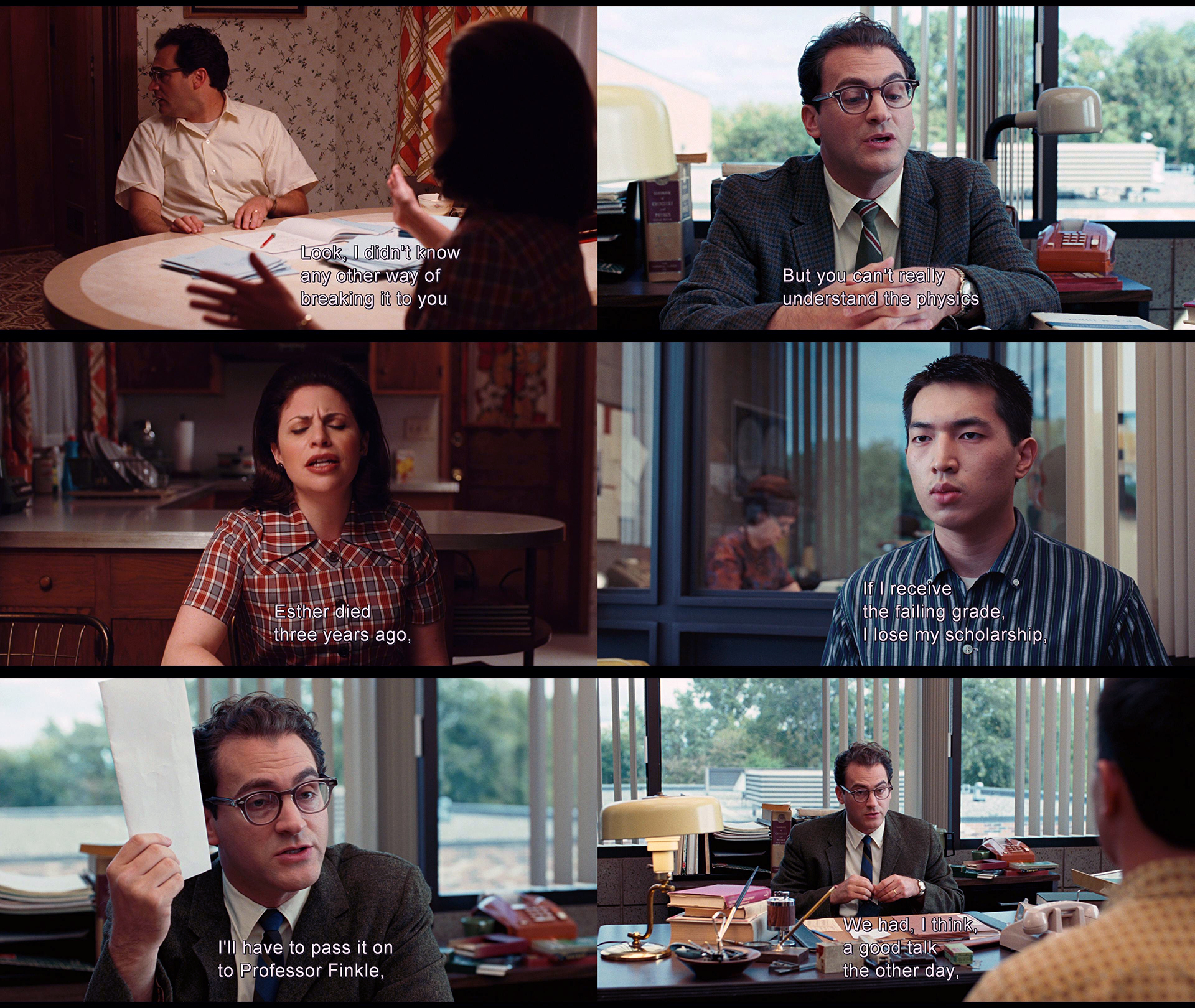
This clip from A Serious Man features a caption with no ending punctuation (signaling the continuation of the speaker’s sentence/turn into the next caption), a caption with an ellipsis for ending punctuation (signaling an interruption of one speaker by another), and a caption with a comma as an ending punctuation mark (also signaling the continuation of the speaker’s turn). The ellipsis and dash are used interchangeably by closed captioners to signal interruptions. Greater consistency is needed. In this chapter, I suggest using the em dash over the ellipsis for marking interruptions.
Source: A Serious Man, 2009. DVD.
A call and response caption from The Order that makes use of preceding hyphens to distinguish speakers
In a simple call and response, one in which both the call and the response occupy the same caption, caption readers may know the response to the call before it has been spoken.
Source: The Order, 2003. DVD. Featured caption is a call and response in the same caption: “- What are they? – Orphans.”
Figure 5.3. An example of a caption covering on-screen text
In this clip from an episode of Arrested Development (“Indian Takers”), Tobias Fünke (David Cross) wears a tuxedo in a mid-shot while looking to his right. The yellow on-screen text, placed bottom-center in two lines, reads: “Tobias Fünke/Lindsay’s acting husband.” This phrase is more than a basic character description. It holds a double meaning because Tobias is an actor and he continually makes remarks that undercut his own presumed heterosexuality. A bottom-center caption covers the on-screen text in this frame: “who should have taken more.” Making matters worse: Both text and caption are set in the same yellow font color. Netflix captions are yellow by default. Netflix customers can customize the typeface, size, and color of the captions but not change their placement. Netflix, 2013.
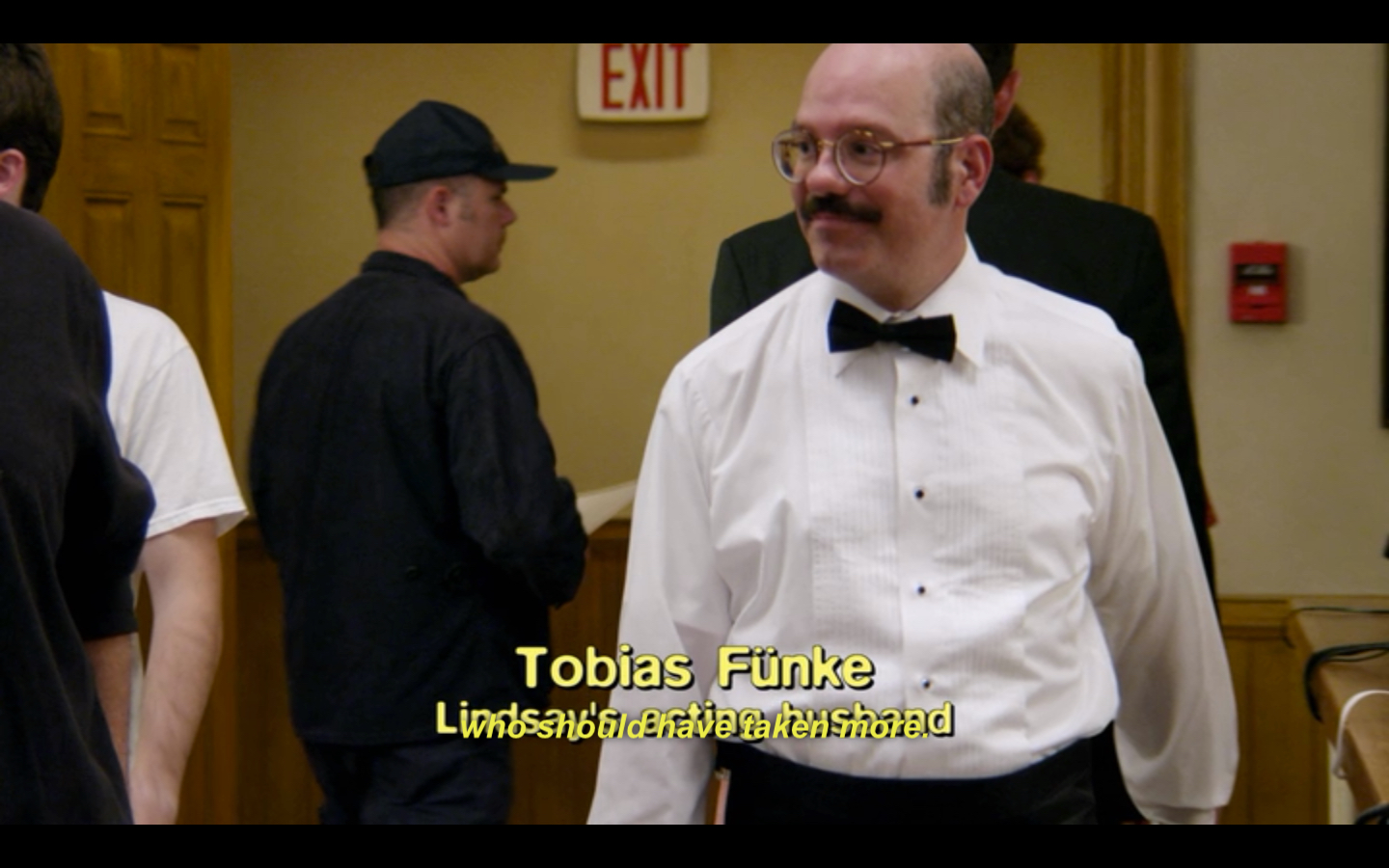
When I returned to this episode to grab the full clip, the captions had been edited. Placement was now being used throughout the opening scenes so the credits and other on-screen text wouldn’t be covered.
Source: Arrested Development, “Indian Takers,” 2013. Netflix. The technique of positioning moved the captions to the top of the screen and away from the on-screen text at the bottom of the screen.
Table 5.1. Eight pairs of captions from A Serious Man showing examples of interruptive ellipses
The first caption of each pair ends with an interruption, which is denoted by an ellipsis. The second caption of each pair is the second speaker’s interruption. Focus Features, 2009.
| 171 Sy has come into my life, and I… 172 Come into your… What does that mean? You barely know him. |
185 Look, Sy feels that we should… 186 Esther is barely cold! |
| 285 Thanks, Sy, but I’m not… 286 Listen, I insist, Larry. There’s no cause for discomfort. |
409 The kids aren’t… 410 I’m saying “we.” I’m not pointing fingers. |
| 492 He tried to tell me about this thing he’s working on, this… 493 The Mentaculus. |
541 I was hoping that Rabbi Nachtner could… 542 That he would… He would… Yes? |
| 615 Although she is planning to marry Sy Ableman, but they… 616 Sy Ableman! |
641 The associates, me, for instance, bill at… 642 Call for Mr. Gopnik. Danny at home. |
End-of-caption ellipses in A Serious Man
This clip features an end-of-caption ellipsis to signal an interruption of one speaker by another (“but they…/Sy Ableman!”). The ellipsis is also used in this clip (though not at the end of captions) to signal another interruption (“But they…”), a pause following a discourse marker (“Well…”), and faltering speech (“Not in the sense that… There hasn’t been hanky-panky”).
Source: A Serious Man, 2009. DVD.
The end-of-caption ellipsis serves to indicate a pause in this clip: ““He just…/(INHALING)/…congratulates the bar mitzvah boy every week.”
Source: A Serious Man, 2009. DVD.
In this clip, the end-of-caption ellipsis serves two functions: To mark a pause following a discourse marker (“Well…”), and to mark a falter or hesitation that hangs on repetition (“denigrating you and urging us not to…/Not to grant you tenure”).
Source: A Serious Man, 2009. DVD.
The tense (but also hilarious) phone call between Larry Gopnik (Michael Stuhlbarg) and the Columbia Record guy (voiced by Warren Keith) is full of interruptive ellipses (as well as one end-of-caption faltering ellipsis and two end-of-caption pausing ellipses). As Larry’s frustration and confusion mount, he interrupts the caller repeatedly in an almost predicable pattern of ellipses. Or, coming at this from another angle, viewers know that when the ending punctuation is a comma an interruption will not occur and the same speaker will continue to hold the floor at least into the next caption. Nevertheless, because the ellipsis is made to serve a number of different meanings in this film, its predictive power for readers is limited.
Source: A Serious Man, 2009. DVD.
Figure 5.4. Reading speed is plotted for each of the eleven captions that end in an ellipsis on Saturday Night Live’s “Quick Zoom Theater”
The skit’s captions both help readers make predictions and slightly mute the intensity of the joke by telling us when it will be repeated. The average reading speed of the eleven ellipsis/gag captions is 158 wpm, well within the typical range for caption speed on television. But this single number obscures the wide range of reading speeds, from a low of 64 wpm to a high of 297 wpm. The slower the reading speed, the more time readers have to process the caption’s full meaning and especially the ending ellipsis as a primary signal for the running gag.
Source: Saturday Night Live, “Quick Zoom Theater,” 2006. VH1.
| Time (seconds) | Reading speed (wpm) |
|---|---|
| 19.96 | 125 |
| 26.37 | 196 |
| 34.2 | 180 |
| 43.19 | 114 |
| 51.1 | 64 |
| 60.44 | 205 |
| 65.31 | 297 |
| 70.48 | 117 |
| 79.59 | 81 |
| 109.77 | 244 |
| 141.22 | 120 |
An em dash helps us anticipate the future in Taken
Source: Taken, 2008. DVD. Featured caption: “We can nego–“
An em dash helps us anticipate the future in The Book of Eli
Another example in this vein is from The Book of Eli (2010), a post-apocalyptic Western starring Denzel Washington as Eli. During one tense confrontation in a dusty bar, Eli tells an outlaw named Martz (Evan Jones), “I don’t want any trouble.” Martz responds, “Well, that’s too bad because you got–” Before Martz can finish his line, Eli slams his head into the bar. We see it coming in the dash at the end of Martz’s caption. A dash (or, in this case, an old-style double hyphen) at the end of Martz’s speech caption may not tell us precisely what Denzel Washington will do – or more generally, what will happen next – but it does at least alert us to a radical shift in focus. Heading into that dash, viewers are already primed for violence. Fictionalized saloon confrontations, which rarely end with a hug, are further strained in a post-apocalyptic landscape in which resources are scarce, lawlessness is the norm, and only the strongest survive. Violence is assumed to be inevitable in such a wasteland. It’s just a matter of time. The dash may provide the clue audiences need to recognize when that time has arrived.
Source: The Book of Eli, 2010. DVD. Featured caption: “Well, that’s too bad because you got–“
An astronaut is pulled down into a crater on the tail of an ellipsis mark in Apollo 18
Source: Apollo 18, 2011. DVD. Featured caption: “[Nate] You can’t help me, but you can save your…”
Table 5.2. Additional examples of ending punctuation featuring em dashes and ellipses
| Source | Caption | Type |
|---|---|---|
| 30 Rock, Untitled, 2008 | STUDIO 6H. THIS IS KE– |
Interruption (dash) |
| Psych, “Shawn 2.0,” 2010 | ♪ EVERYBODY WANTS TO RULE THE– ♪ | Pause/Trails off (dash) |
| Futurama, Bender’s Big Score, 2007 | We’re not unemploy… | Interruption (ellipsis) |
| Futurama, “Free Will Hunting,” 2012 | Are you suggesting that any verdict I reach is simply the output of a pre-programmed… |
Interruption (ellipsis) |
| Family Guy, “Lois Kills Stewie,” 2007 | Well, at least it didn’t end like The Sopranos, where it just cut to black in mid… |
Interruption (ellipsis) |
| Castle, “Hell Hath No Fury,” 2009 | EGOTISTICAL AND COMPLETELY– | Interruption (dash) |
Source: 30 Rock, “Untitled,” 2008. Comedy Central. Featured caption: “STUDIO 6H. THIS IS KE–“
Source: Psych, “Shawn 2.0,” 2010. Ion Television. Featured caption: “♪ EVERYBODY WANTS TO RULE THE– ♪”
Source: Futurama, “Free Will Hunting,” 2012. Comedy Central. Featured captions: “We’re not unemploy…”
The end-of-caption ellipsis is used twice to mark interruptions in the following clip from Futurama. First, the lawyer interrupts the robot Judge in mid-sentence with (squawks). Later, the COMPUTER VOICE (a program within the robot Judge) interrupts the Judge mid-sentence. The end-of-caption ellipsis is used a third time to signal a pause (“in scientific circles as a ‘robot’…”), which suggests a need for greater consistency in how this mark of punctuation is used. I suggest using the em dash for end-of-caption interruptions and the ellipsis for end-of-caption pauses, hesitations, and faltering speech.
Source: Futurama, “Free Will Hunting,” 2012. Comedy Central. Featured captions: “But by your client’s own admission…” and “Are you suggesting that any verdict I reach/ is simply the output of a pre-programmed…”
Source: Family Guy, “Lois Kills Stewie,” 2007. DVD. Featured captions: “Well, at least it didn’t end like The Sopranos,/ where it just cut to black in mid…”
Source: Castle, “Hell Hath No Fury,” 2009. TNT Network. Featured caption: “EGOTISTICAL AND COMPLETELY–”
Source: Paul, 2011. DVD. The clip uses an ellipsis to alert us to a forthcoming interruption when a bird slams into the RV window: “But don’t worry. I got it all under…”
Table 5.3. Some examples of off-screen speaker identification in Game of Thrones
A number of new scenes in “The North Remembers” (Season 2, Episode 1) open with establishing or panning shots as characters begin speaking off-screen. HBO, 2012. DVD.
| Description | Caption | Context |
|---|---|---|
| A tracking shot of a raven cage being brought into the council room as Pycelle begins speaking off-screen. The Speaker ID appears at the start of the tracking shot. | PYCELLE: A raven arrived from the citadel this morning, Your Grace. | New scene |
| An establishing shot of a soldier outside the castle at Winterfell. Someone identified in the captions as Leadranach, a non-recurring character, begins speaking over the establishing shot before the scene cuts to the inside of the castle and eventually shows us Leadranach addressing the young lord at Winterfell. The establishing shot lasts 6.35 seconds. The speech and captioned identification of Leadranach begin one second into the establishing shot, and approximately eight seconds before we see Leadranach. | LEADRANACH: My lord, may the old gods watch over your brother | New scene |
| A panning shot over the city that settles on Shae standing on a balcony overlooking the city. The caption appears 2.58 seconds into the panning shot and about five seconds before we see Shae. | SHAE: This city stinks. | New scene |
| An audio offset of almost two seconds as the camera lingers on the previous scene while the audio from the next scene begins. Robb begins speaking as the camera stays with the previous scene, which is fitting given the previous scene’s intensity. It’s as though the intensity anchors the camera to the previous scene, and the audio of the next scene dislodges the camera. | ROBB: You’re Ser Alton Lannister? | New scene |
Source: Game of Thrones, “The North Remembers,” 2012. DVD. Featured caption: “PYCELLE: A raven arrived from the citadel this morning, Your Grace.”
Source: Game of Thrones, “The North Remembers,” 2012. DVD. Featured caption: “LEADRANACH: My lord, may the old gods watch over your brother”
Source: Game of Thrones, “The North Remembers,” 2012. DVD. Featured caption: “SHAE: This city stinks.”
Source: Game of Thrones, “The North Remembers,” 2012. DVD. Featured caption: “ROBB: You’re Ser Alton Lannister?”
Tyrion whistling at the start of a new scene in Game of Thrones
Source: Game of Thrones, “The North Remembers,” 2012. DVD. Featured caption: (TYRION WHISTLING TUNE)
The unknown taxi driver is named in Unknown
Source: Unknown, 2011. DVD. Featured caption: [GINA SCREAMS].
Identifying Paul the dog and Young Tara in the opening of Paul
Source: Paul, 2011. DVD. Featured captions: (PAUL THE DOG BARKS), “YOUNG TARA: Go on then, Paul.”
Prematurely revealing the natives as cannibals in Pirates of the Caribbean: Dead Man’s Chest
Source: Pirates of the Caribbean: Dead Man’s Chest, 2006. DVD. Featured captions: (speaks cannibals’ language), (cannibals’ language), (cannibals murmur), (cannibals’ language), and (cannibals’ language).
Identifying the mysterious cowboy as Transylvanian and Billy the Kid in Bloodrayne II: Deliverance
Source: Bloodrayne II: Deliverance, 2007. Cable TV (Chiller). Featured caption: (Billy the Kid, in Transylvanian accent).
Source: Bloodrayne II: Deliverance, 2007. DVD. Featured caption: “(cowboy) Are you sad, children?”
A 2012 Allstate commercial featuring Kyle and Roger
Source: Allstate television commercial, 2012. Featured captions: “[ Kyle with voice of Dennis ] …THE Allstate Value Plan” and “I TOO HAVE… [ Roger with voice of Dennis ] …Allstate.”
Dubbed speech or voice replacement is challenging to represent in the fast-paced environment of television commercials. In a second version of this commercial, the dubbed speech is streamlined from [ Roger with voice of Dennis ] to just [ Dennis].
Source: Allstate television commercial, 2012. Featured captions: “[ Dennis ] …THE Allstate Value Plan” and “I TOO HAVE… [ Dennis ] …Allstate.”
Figure 5.5. A visual representation of the CLARK and SUPERMAN speaker identifiers in Man of Steel
CLARK speaker identifiers
Source: Man of Steel, 2013. DVD. Featured captions: “CLARK: I’m tired of safe.” and “CLARK: I didn’t say that.”
Superman is partly named for the first time by Lois Lane
It is only after Clark is forced to come out of hiding and reveal his true alien identity to the evil Zod and the U.S. government that the Speaker IDs for Clark shift to SUPERMAN. This shift occurs in the captions nearly simultaneously with the naming of the superhero by Lois Lane, with one key difference: Lois is interrupted before she can finish saying the name the audience knows is coming (“How about…Super—” at 01:11:40). (Note the proper use of an em dash to mark the interruption of Lois by someone in the other room.) Two seconds later, Clark/Superman is identified for the first time in the captions as SUPERMAN. The second half of the movie belongs to SUPERMAN.
Source: Man of Steel, 2013. DVD. Featured captions: “How about…/…Super–“
A string of SUPERMAN speaker identifiers in a span of ten seconds
The first face-to-face meeting between Superman and Zod coincides with four SUPERMAN Speaker IDs in a span of ten seconds (01:16:59 – 01:17:09). Because they occur in the scene immediately following the interrupted naming scene (“Super—”), these Speaker IDs cement Clark’s new status as Superman in the minds of caption readers. But no one actually utters the S-word (i.e. Superman) in this scene. In fact, “Superman” is only uttered three times (not including Lois’ interrupted S-word) in the entire film. In the span of about eight seconds towards the end of the movie, and after the SUPERMAN Speaker ID has already been used nine times, two minor military characters have the following quick exchange about the S-word.
Source: Man of Steel, 2013. DVD. Featured captions include four SUPERMAN identifiers in a span of ten seconds.
“Superman” is uttered only three times in quick succession at the end of the movie
Source: Man of Steel, 2013. DVD.
Playing name that tune on Family Guy
Source: Family Guy, “And then there were fewer,” 2010. Adult Swim TV network. Featured captions: (hums theme to Lost in Space), (hums theme to Dick van Dyke Show), and (hums theme to Dynasty).
Source: Family Guy, “And then there were fewer,” 2010. DVD. Featured captions: (HUMMING TUNE), (HUMMING TUNE), and (HUMMING TUNE).
On-screen/uncaptioned textual irony
Source: Always Sunny in Philadelphia, “Sweet Dee Gets Audited,” 2011. Comedy Central.
Source: Always Sunny in Philadelphia, “Sweet Dee Has a Heart Attack,” 2009. DVD.
Source: Always Sunny in Philadelphia, “Dennis and Dee Go on Welfare,” 2006. DVD.
Source: The Big Year, 2011. DVD.
Unintentional textual irony
Television commercials generate ironic tensions unintentionally when they bump up against each other or against the TV programming they’re sponsoring. For example, a Kentucky Fried Chicken (KFC) commercial received a lot of buzz on Twitter in November 2012 after their ad immediately followed a scene from The Walking Dead (“When the Dead Come Knocking”) featuring a hoard of zombies feasting on the entrails of an unfortunate victim. As the bloody zombie frenzy cuts away to a logo for The Walking Dead, an announcer says, “Brought to you by KFC.” The logo is quickly replaced with an image of a bucket of KFC chicken as the announcer urges viewers to “Come in today and taste why fresh is better” (SpecialK1417 2012).
Source: The Walking Dead, “Sick,” 2012. AMC Network. Featured caption: (walkers munching)
Source: Terminator 3, 2003. Syfy Network. Featured caption: [SIZZLING]
A caption from a Celebrex TV commercial wanders into The Walking Dead
Despite the large number of examples discussed online of juxtaposition in popular culture, closed captions are rarely mentioned in such discussions. I found only one example of captioned juxtaposition discussed online, a screenshot posted to Reddit in which a closed caption from The Tudors (a Showtime series rebroadcast on Hulu Plus) lingered on the screen during a commercial for IKEA (jeredhead 2013). The commercial featured a small boy on a four-wheeled baby scooter. Lingering on the screen was the inappropriately humorous caption: [Sexual moaning]. While this post to the /r/funny subreddit was not intended to elicit a discussion of ironic juxtaposition, it nonetheless begins to suggest how closed captioning can participate in such discussions. Captions routinely cross boundaries they shouldn’t, as when a caption stays on the screen during a commercial break or when one commercial is replaced by another commercial.
Unlike more conventional types of juxtaposition in which elements are placed next to each other in time or space, captioned juxtaposition involves superimposing elements on top of each other. The superimposed or lingering caption is like a foreign body invading a new host. For example, when an episode of The Walking Dead (“This Sorrowful Life,” 2013) resumed after a commercial break, a Celebrex commercial’s final caption lingered on the screen: “For a body in motion.” Celebrex is a pain reliever for arthritis. This final Celebrex caption remained on the screen as a small number of zombies wandered aimlessly along a roadside. The unintended irony of such a juxtaposition is located in the degree to which viewers recognize the zombies as pure body too, as mindless but constantly in motion. The Celebrex motto has the potential to be ironic if we think of zombies as having a similar tendency to stay in motion: “A BODY AT REST TENDS TO STAY AT REST…WHILE A BODY IN MOTION TENDS TO STAY IN MOTION.” Does this ironic link between medicated bodies and zombie bodies subtly encourage us to perform a zombie re-reading in which pharmaceutical ads seem to be populated with mindless, docile and sedated bodies in motion? Probably not. But even if we don’t go out on this interpretative limb, we may still find that this lingering caption creates an unintended and ironic link between very different “bodies in motion.”
Source: Celebrex television commercial, 2013. AMC Network. A final caption, “FOR A BODY IN MOTION,” wanders into the episode of The Walking Dead like a zombie.
Figure 5.6. A frame from a Subaru TV commercial showing two sisters getting ready to jump into an automobile’s hatchback trunk.
Source: CNN, May 8, 2013. As the live news coverage breaks for commercial, a lingering caption persists on the screen at the start of the Subaru commercial: “KIDNAPPED AT THE AGE OF NINE, HELD IN A DUNGEON.”
A caption from a Priceline TV commercial stays on the screen very briefly at the start of a Chili’s commercial
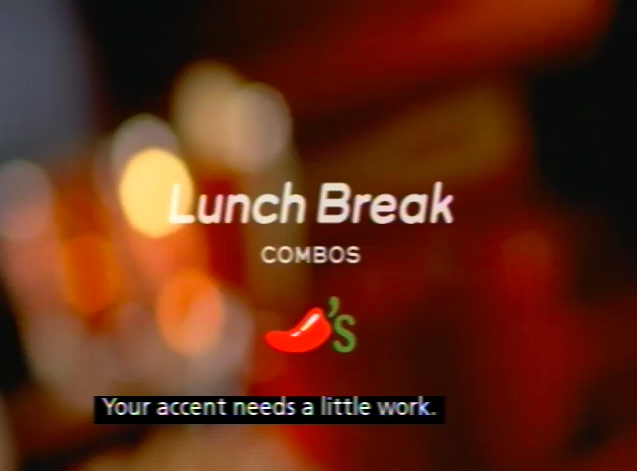
Source: TV commercial. Featured caption: “Your accent needs a little work.”
Bonus content: Mismatched captions
When closed captions don’t just temporarily occupy the space of their neighbors but take over that space, replacing the program’s official caption track entirely, program and caption merge into an entirely new text.
A Reddit user posted this example on January 10, 2016 of a children’s animated show displaying the wrong caption track. Apparently, the children’s show was streaming the caption track from an episode of Code Black, a “heart-pounding medical drama” (CBS.com). In the Reddit user’s photo, an infant child lays on his stomach looking up at the TV screen. On the TV, an animated bee is centered in the frame and appears to be speaking directly to the viewer. The caption at the bottom of the screen says, “Try hiding something, your mama will find out.” An ironic caption indeed if you can imagine characters on the animated program talking to viewers about their mommies and daddies. In a second photo, the violent caption can’t be reconciled with the non-violent children’s programming: “I love you so much, I want to punch your face in.”

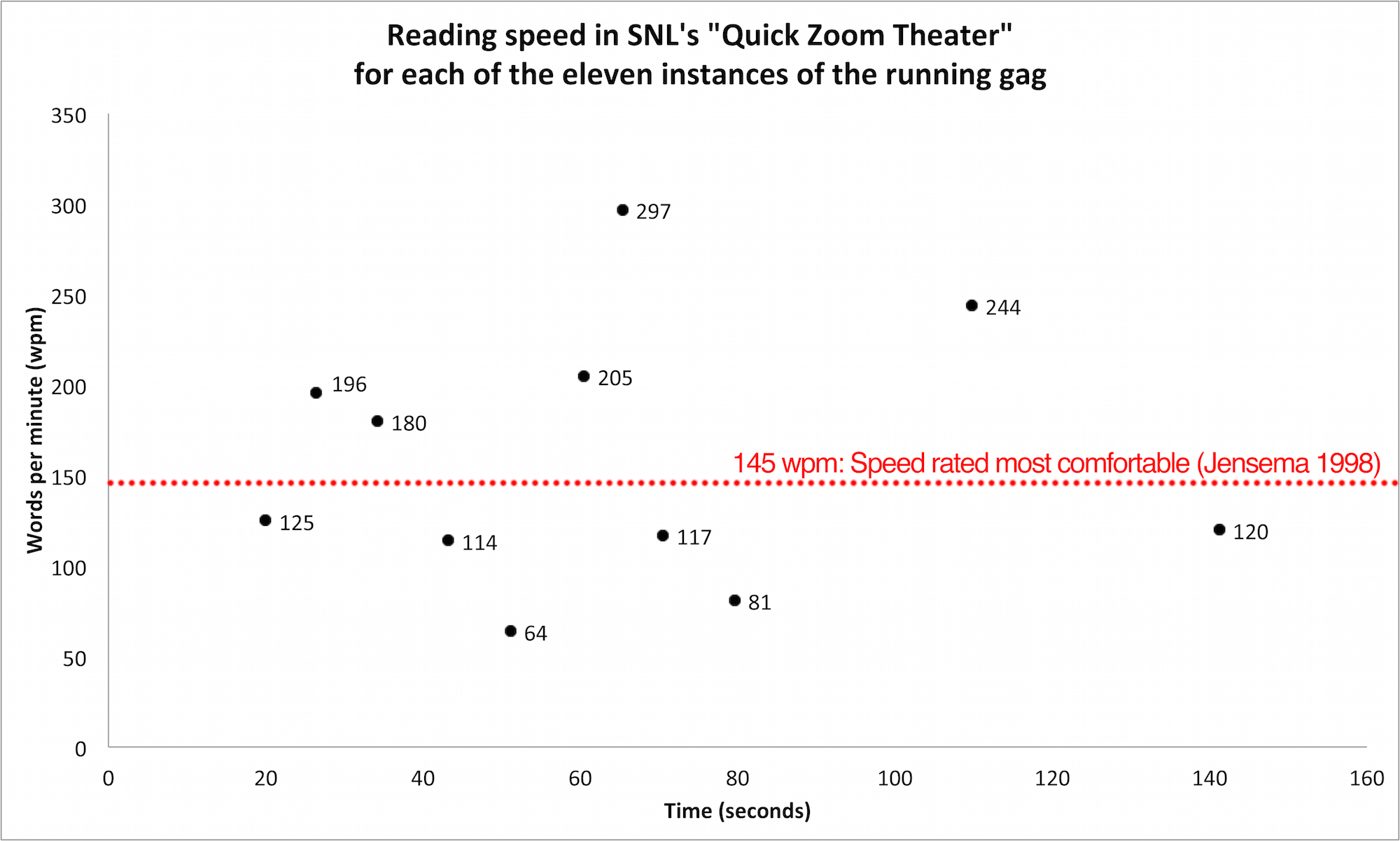
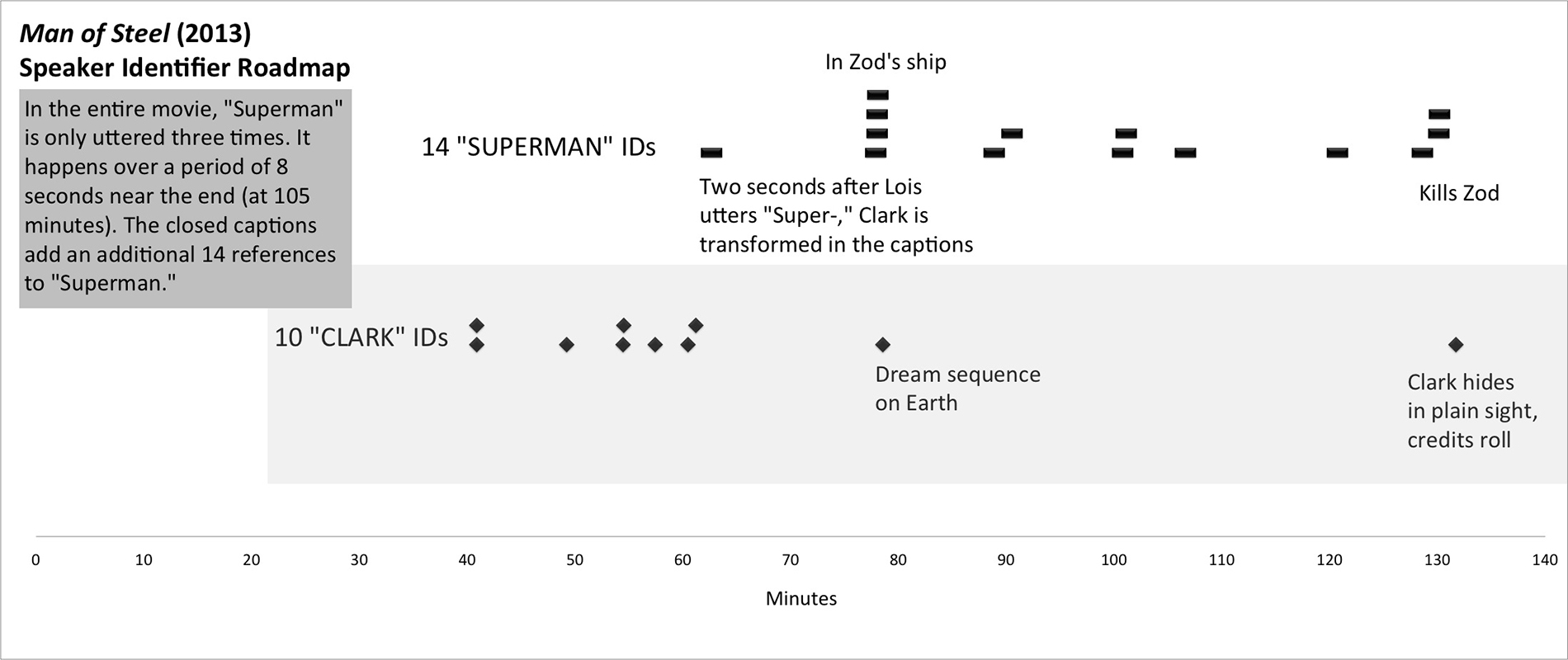
![A frame from an Ikea commercial featuring a young boy riding a child's trike. A caption from the previous program lingers on the screen: [Sexual moaning]](https://readingsounds.net/wp-content/uploads/2014/12/tudors-ikea-sexualmoaning.jpg)
